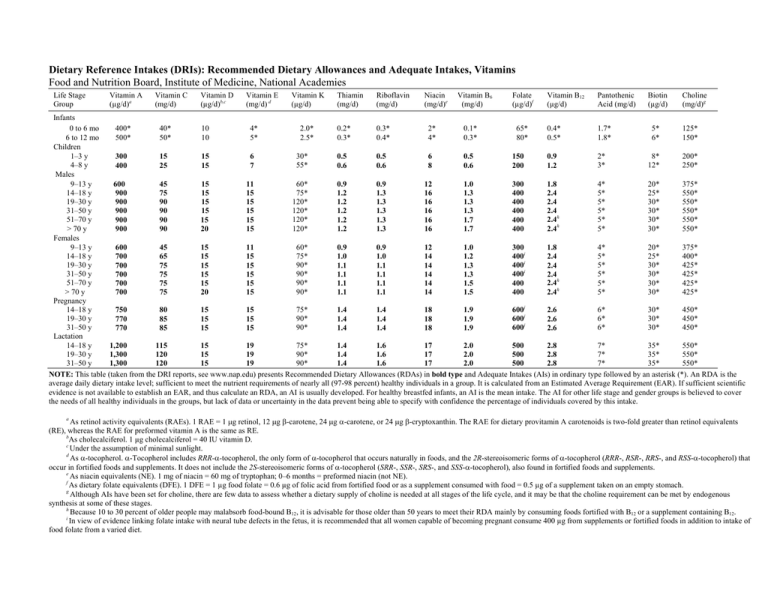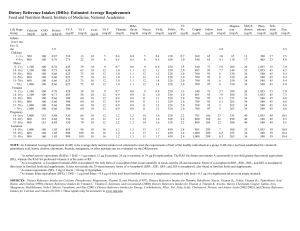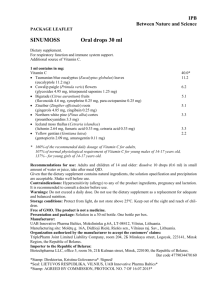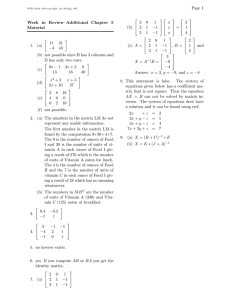Dietary Reference Intakes (DRIs) for Vitamins & Elements
advertisement

Dietary Reference Intakes (DRIs): Recommended Dietary Allowances and Adequate Intakes, Vitamins Food and Nutrition Board, Institute of Medicine, National Academies Life Stage Group Vitamin A (µg/d)a Vitamin C (mg/d) Vitamin D (µg/d)b,c Vitamin E (mg/d) d Vitamin K (µg/d) Thiamin (mg/d) Riboflavin (mg/d) Niacin (mg/d)e Vitamin B6 (mg/d) Folate (µg/d)f Vitamin B12 (µg/d) Pantothenic Acid (mg/d) Biotin (µg/d) Choline (mg/d)g Infants 0 to 6 mo 400* 40* 10 4* 2.0* 0.2* 0.3* 2* 0.1* 65* 0.4* 1.7* 5* 125* 6 to 12 mo 500* 50* 10 5* 2.5* 0.3* 0.4* 4* 0.3* 80* 0.5* 1.8* 6* 150* Children 2* 8* 200* 30* 1–3 y 0.5 0.5 6 0.5 150 0.9 300 15 15 6 4–8 y 55* 3* 12* 250* 400 25 15 7 0.6 0.6 8 0.6 200 1.2 Males 4* 20* 375* 60* 9–13 y 0.9 0.9 12 1.0 300 1.8 600 45 15 11 14–18 y 75* 5* 25* 550* 900 75 15 15 1.2 1.3 16 1.3 400 2.4 19–30 y 120* 5* 30* 550* 900 90 15 15 1.2 1.3 16 1.3 400 2.4 31–50 y 120* 5* 30* 550* 900 90 15 15 1.2 1.3 16 1.3 400 2.4 51–70 y 120* 2.4h 5* 30* 550* 900 90 15 15 1.2 1.3 16 1.7 400 h 5* 30* 550* > 70 y 120* 2.4 900 90 20 15 1.2 1.3 16 1.7 400 Females 4* 20* 375* 60* 9–13 y 0.9 0.9 12 1.0 300 1.8 600 45 15 11 14–18 y 75* 400i 5* 25* 400* 700 65 15 15 1.0 1.0 14 1.2 2.4 5* 30* 425* 19–30 y 90* 400i 2.4 700 75 15 15 1.1 1.1 14 1.3 31–50 y 90* 400i 5* 30* 425* 700 75 15 15 1.1 1.1 14 1.3 2.4 h 51–70 y 90* 2.4 5* 30* 425* 700 75 15 15 1.1 1.1 14 1.5 400 5* 30* 425* > 70 y 90* 2.4h 700 75 20 15 1.1 1.1 14 1.5 400 Pregnancy 14–18 y 75* 600j 6* 30* 450* 750 80 15 15 1.4 1.4 18 1.9 2.6 6* 30* 450* 19–30 y 90* 600j 2.6 770 85 15 15 1.4 1.4 18 1.9 31–50 y 90* 600j 6* 30* 450* 770 85 15 15 1.4 1.4 18 1.9 2.6 Lactation 14–18 y 75* 7* 35* 550* 1,200 115 15 19 1.4 1.6 17 2.0 500 2.8 19–30 y 90* 7* 35* 550* 1,300 120 15 19 1.4 1.6 17 2.0 500 2.8 31–50 y 90* 7* 35* 550* 1,300 120 15 19 1.4 1.6 17 2.0 500 2.8 NOTE: This table (taken from the DRI reports, see www.nap.edu) presents Recommended Dietary Allowances (RDAs) in bold type and Adequate Intakes (AIs) in ordinary type followed by an asterisk (*). An RDA is the average daily dietary intake level; sufficient to meet the nutrient requirements of nearly all (97-98 percent) healthy individuals in a group. It is calculated from an Estimated Average Requirement (EAR). If sufficient scientific evidence is not available to establish an EAR, and thus calculate an RDA, an AI is usually developed. For healthy breastfed infants, an AI is the mean intake. The AI for other life stage and gender groups is believed to cover the needs of all healthy individuals in the groups, but lack of data or uncertainty in the data prevent being able to specify with confidence the percentage of individuals covered by this intake. a As retinol activity equivalents (RAEs). 1 RAE = 1 μg retinol, 12 μg β-carotene, 24 μg α-carotene, or 24 μg β-cryptoxanthin. The RAE for dietary provitamin A carotenoids is two-fold greater than retinol equivalents (RE), whereas the RAE for preformed vitamin A is the same as RE. b As cholecalciferol. 1 µg cholecalciferol = 40 IU vitamin D. c Under the assumption of minimal sunlight. d As α-tocopherol. α-Tocopherol includes RRR-α-tocopherol, the only form of α-tocopherol that occurs naturally in foods, and the 2R-stereoisomeric forms of α-tocopherol (RRR-, RSR-, RRS-, and RSS-α-tocopherol) that occur in fortified foods and supplements. It does not include the 2S-stereoisomeric forms of α-tocopherol (SRR-, SSR-, SRS-, and SSS-α-tocopherol), also found in fortified foods and supplements. e As niacin equivalents (NE). 1 mg of niacin = 60 mg of tryptophan; 0–6 months = preformed niacin (not NE). f As dietary folate equivalents (DFE). 1 DFE = 1 µg food folate = 0.6 µg of folic acid from fortified food or as a supplement consumed with food = 0.5 µg of a supplement taken on an empty stomach. g Although AIs have been set for choline, there are few data to assess whether a dietary supply of choline is needed at all stages of the life cycle, and it may be that the choline requirement can be met by endogenous synthesis at some of these stages. h Because 10 to 30 percent of older people may malabsorb food-bound B12, it is advisable for those older than 50 years to meet their RDA mainly by consuming foods fortified with B12 or a supplement containing B12. i In view of evidence linking folate intake with neural tube defects in the fetus, it is recommended that all women capable of becoming pregnant consume 400 µg from supplements or fortified foods in addition to intake of food folate from a varied diet. j It is assumed that women will continue consuming 400 µg from supplements or fortified food until their pregnancy is confirmed and they enter prenatal care, which ordinarily occurs after the end of the periconceptional period—the critical time for formation of the neural tube. SOURCES: Dietary Reference Intakes for Calcium, Phosphorous, Magnesium, Vitamin D, and Fluoride (1997); Dietary Reference Intakes for Thiamin, Riboflavin, Niacin, Vitamin B6, Folate, Vitamin B12, Pantothenic Acid, Biotin, and Choline (1998); Dietary Reference Intakes for Vitamin C, Vitamin E, Selenium, and Carotenoids (2000); Dietary Reference Intakes for Vitamin A, Vitamin K, Arsenic, Boron, Chromium, Copper, Iodine, Iron, Manganese, Molybdenum, Nickel, Silicon, Vanadium, and Zinc (2001); Dietary Reference Intakes for Water, Potassium, Sodium, Chloride, and Sulfate (2005); and Dietary Reference Intakes for Calcium and Vitamin D (2011). These reports may be accessed via www.nap.edu. Dietary Reference Intakes (DRIs): Recommended Dietary Allowances and Adequate Intakes, Elements Food and Nutrition Board, Institute of Medicine, National Academies Life Stage Group Calcium (mg/d) Chromium (µg/d) Copper (µg/d) Fluoride (mg/d) Iodine (µg/d) Iron (mg/d) Magnesium (mg/d) Manganese (mg/d) Molybdenum (µg/d) Phosphorus (mg/d) Selenium (µg/d) Zinc (mg/d) Potassium (g/d) Sodium Chloride (g/d) (g/d) Infants 0 to 6 mo 200* 0.2* 200* 0.01* 110* 0.27* 30* 0.003* 2* 100* 15* 2* 0.4* 0.12* 0.18* 6 to 12 mo 260* 5.5* 220* 0.5* 130* 75* 0.6* 3* 275* 20* 0.7* 0.37* 0.57* 11 3 Children 3.0* 1.0* 1.5* 1–3 y 11* 0.7* 1.2* 700 340 90 7 80 17 460 20 3 4–8 y 15* 1* 1.5* 3.8* 1.2* 1.9* 1,000 440 90 10 130 22 500 30 5 Males 4.5* 1.5* 2.3* 1.9* 25* 2* 9–13 y 34 1,250 40 8 700 120 8 240 1,300 14–18 y 35* 3* 2.2* 4.7* 1.5* 2.3* 1,300 890 150 11 410 43 1,250 55 11 19–30 y 35* 4* 2.3* 4.7* 1.5* 2.3* 1,000 900 150 8 400 45 700 55 11 31–50 y 35* 4* 2.3* 4.7* 1.5* 2.3* 1,000 900 150 8 420 45 700 55 11 51–70 y 30* 4* 2.3* 4.7* 1.3* 2.0* 1,000 900 150 8 420 45 700 55 11 > 70 y 30* 4* 2.3* 4.7* 1.2* 1.8* 1,200 900 150 8 420 45 700 55 11 Females 4.5* 1.5* 2.3* 1.6* 21* 2* 9–13 y 34 1,250 40 8 700 120 8 240 1,300 14–18 y 24* 3* 1.6* 4.7* 1.5* 2.3* 1,300 890 150 15 360 43 1,250 55 9 19–30 y 25* 3* 1.8* 4.7* 1.5* 2.3* 1,000 900 150 18 310 45 700 55 8 31–50 y 25* 3* 1.8* 4.7* 1.5* 2.3* 1,000 900 150 18 320 45 700 55 8 51–70 y 20* 3* 1.8* 4.7* 1.3* 2.0* 45 700 55 1,200 900 150 8 320 8 > 70 y 20* 3* 1.8* 4.7* 1.2* 1.8* 1,200 900 150 8 320 45 700 55 8 Pregnancy 14–18 y 29* 3* 2.0* 4.7* 1.5* 2.3* 1,300 1,000 220 27 400 50 1,250 60 12 19–30 y 30* 3* 2.0* 4.7* 1.5* 2.3* 1,000 1,000 220 27 350 50 700 60 11 31–50 y 30* 3* 2.0* 4.7* 1.5* 2.3* 1,000 1,000 220 27 360 50 700 60 11 Lactation 14–18 y 44* 3* 2.6* 5.1* 1.5* 2.3* 1,300 1,300 290 10 360 50 1,250 70 13 19–30 y 45* 3* 2.6* 5.1* 1.5* 2.3* 1,000 1,300 290 9 310 50 700 70 12 31–50 y 45* 3* 2.6* 5.1* 1.5* 2.3* 1,000 1,300 290 9 320 50 700 70 12 NOTE: This table (taken from the DRI reports, see www.nap.edu) presents Recommended Dietary Allowances (RDAs) in bold type and Adequate Intakes (AIs) in ordinary type followed by an asterisk (*). An RDA is the average daily dietary intake level; sufficient to meet the nutrient requirements of nearly all (97-98 percent) healthy individuals in a group. It is calculated from an Estimated Average Requirement (EAR). If sufficient scientific evidence is not available to establish an EAR, and thus calculate an RDA, an AI is usually developed. For healthy breastfed infants, an AI is the mean intake. The AI for other life stage and gender groups is believed to cover the needs of all healthy individuals in the groups, but lack of data or uncertainty in the data prevent being able to specify with confidence the percentage of individuals covered by this intake. SOURCES: Dietary Reference Intakes for Calcium, Phosphorous, Magnesium, Vitamin D, and Fluoride (1997); Dietary Reference Intakes for Thiamin, Riboflavin, Niacin, Vitamin B6, Folate, Vitamin B12, Pantothenic Acid, Biotin, and Choline (1998); Dietary Reference Intakes for Vitamin C, Vitamin E, Selenium, and Carotenoids (2000); and Dietary Reference Intakes for Vitamin A, Vitamin K, Arsenic, Boron, Chromium, Copper, Iodine, Iron, Manganese, Molybdenum, Nickel, Silicon, Vanadium, and Zinc (2001); Dietary Reference Intakes for Water, Potassium, Sodium, Chloride, and Sulfate (2005); and Dietary Reference Intakes for Calcium and Vitamin D (2011). These reports may be accessed via www.nap.edu. Dietary Reference Intakes (DRIs): Tolerable Upper Intake Levels, Vitamins Food and Nutrition Board, Institute of Medicine, National Academies Life Stage Group Vitamin A (µg/d)a Vitamin C (mg/d) Vitamin D (μg/d) Vitamin E (mg/d)b,c Vitamin K Thiamin Riboflavin Niacin (mg/d)c Vitamin B6 (mg/d) Folate (μg/d)c Vitamin B12 Pantothenic Acid Biotin Choline (g/d) Carotenoidsd Infants 0 to 6 mo 600 NDe 25 ND ND ND ND ND ND ND ND ND ND ND ND 6 to 12 mo 600 ND 38 ND ND ND ND ND ND ND ND ND ND ND ND Children 1−3 y 600 400 63 200 ND ND ND 10 30 300 ND ND ND 1.0 ND 4−8 y 900 650 75 300 ND ND ND 15 40 400 ND ND ND 1.0 ND Males 9−13 y 1,700 1,200 100 600 ND ND ND 20 60 600 ND ND ND 2.0 ND 14−18 y 2,800 1,800 100 800 ND ND ND 30 80 800 ND ND ND 3.0 ND ND ND 35 100 1,000 ND ND ND 3.5 ND 19−30 y 3,000 2,000 100 1,000 ND 31−50 y 3,000 2,000 100 1,000 ND ND ND 35 100 1,000 ND ND ND 3.5 ND 51−70 y 3,000 2,000 100 1,000 ND ND ND 35 100 1,000 ND ND ND 3.5 ND > 70 y 3,000 2,000 100 1,000 ND ND ND 35 100 1,000 ND ND ND 3.5 ND Females 9−13 y 1,700 1,200 100 600 ND ND ND 20 60 600 ND ND ND 2.0 ND 14−18 y 2,800 1,800 100 800 ND ND ND 30 80 800 ND ND ND 3.0 ND 19−30 y 3,000 2,000 100 1,000 ND ND ND 35 100 1,000 ND ND ND 3.5 ND ND ND 3.5 ND 31−50 y 3,000 2,000 100 1,000 ND ND ND 35 100 1,000 ND 51−70 y 3,000 2,000 100 1,000 ND ND ND 35 100 1,000 ND ND ND 3.5 ND > 70 y 3,000 2,000 100 1,000 ND ND ND 35 100 1,000 ND ND ND 3.5 ND Pregnancy 14−18 y 2,800 1,800 100 800 ND ND ND 30 80 800 ND ND ND 3.0 ND 19−30 y 3,000 2,000 100 1,000 ND ND ND 35 100 1,000 ND ND ND 3.5 ND 31−50 y 3,000 2,000 100 1,000 ND ND ND 35 100 1,000 ND ND ND 3.5 ND Lactation 14−18 y 2,800 1,800 100 800 ND ND ND 30 80 800 ND ND ND 3.0 ND 2,000 100 1,000 ND ND ND 35 100 1,000 ND ND ND 3.5 ND 19−30 y 3,000 31−50 y 3,000 2,000 100 1,000 ND ND ND 35 100 1,000 ND ND ND 3.5 ND NOTE: A Tolerable Upper Intake Level (UL) is the highest level of daily nutrient intake that is likely to pose no risk of adverse health effects to almost all individuals in the general population. Unless otherwise specified, the UL represents total intake from food, water, and supplements. Due to a lack of suitable data, ULs could not be established for vitamin K, thiamin, riboflavin, vitamin B12, pantothenic acid, biotin, and carotenoids. In the absence of a UL, extra caution may be warranted in consuming levels above recommended intakes. Members of the general population should be advised not to routinely exceed the UL. The UL is not meant to apply to individuals who are treated with the nutrient under medical supervision or to individuals with predisposing conditions that modify their sensitivity to the nutrient. a As preformed vitamin A only. b As α-tocopherol; applies to any form of supplemental α-tocopherol. c The ULs for vitamin E, niacin, and folate apply to synthetic forms obtained from supplements, fortified foods, or a combination of the two. d β-Carotene supplements are advised only to serve as a provitamin A source for individuals at risk of vitamin A deficiency. e ND = Not determinable due to lack of data of adverse effects in this age group and concern with regard to lack of ability to handle excess amounts. Source of intake should be from food only to prevent high levels of intake. SOURCES: Dietary Reference Intakes for Calcium, Phosphorous, Magnesium, Vitamin D, and Fluoride (1997); Dietary Reference Intakes for Thiamin, Riboflavin, Niacin, Vitamin B6, Folate, Vitamin B12, Pantothenic Acid, Biotin, and Choline (1998); Dietary Reference Intakes for Vitamin C, Vitamine E, Selenium, and Carotenoids (2000); Dietary Reference Intakes for Vitamin A, Vitamin K, Arsenic, Boron, Chromium, Copper, Iodine, Iron, Manganese, Molybdenum, Nickel, Silicon, Vanadium, and Zinc (2001); and Dietary Reference Intakes for Calcium and Vitamin D (2011). These reports may be accessed via www.nap.edu. Dietary Reference Intakes (DRIs): Tolerable Upper Intake Levels, Elements Food and Nutrition Board, Institute of Medicine, National Academies Life Stage Group Infants 0 to 6 mo 6 to 12 mo Children 1−3 y 4−8 y Males 9−13 y 14−18 y 19−30 y 31−50 y 51−70 y > 70 y Females 9−13 y 14−18 y 19−30 y 31−50 y 51−70 y > 70 y Pregnancy 14−18 y 19−30 y 61−50 y Lactation 14−18 y 19−30 y 31−50 y Nickel (mg/d) Phosphorus (g/d) ND ND ND ND ND ND 2 3 300 600 0.2 0.3 350 350 350 350 350 350 6 9 11 11 11 11 1,100 1,700 2,000 2,000 2,000 2,000 40 45 45 45 45 45 350 350 350 350 350 350 6 9 11 11 11 11 900 1,100 1,100 45 45 45 350 350 350 900 1,100 1,100 45 45 45 350 350 350 Arsenic Boron (mg/d) Calcium (mg/d) Chromium NDe ND ND ND 1,000 1,500 ND ND ND ND 0.7 0.9 ND ND 40 40 ND ND ND ND ND ND 3 6 2,500 2,500 ND ND 1,000 3,000 1.3 2.2 200 300 40 40 65 110 ND ND ND ND ND ND 11 17 20 20 20 20 3,000 3,000 2,500 2,500 2,000 2,000 ND ND ND ND ND ND 5,000 8,000 10,000 10,000 10,000 10,000 10 10 10 10 10 10 600 900 1,100 1,100 1,100 1,100 40 45 45 45 45 45 ND ND ND ND ND ND 11 17 20 20 20 20 3,000 3,000 2,500 2,500 2,000 2,000 ND ND ND ND ND ND 5,000 8,000 10,000 10,000 10,000 10,000 10 10 10 10 10 10 600 900 1,100 1,100 1,100 1,100 ND ND ND 17 20 20 3,000 2,500 2,500 ND ND ND 8,000 10,000 10,000 10 10 10 ND ND ND 17 20 20 3,000 2,500 2,500 ND ND ND 8,000 10,000 10,000 10 10 10 a Copper (µg/d) Fluoride (mg/d) Iodine (µg/d) Iron (mg/d) Magnesium (mg/d)b Manganese (mg/d) Molybdenum (µg/d) Selenium (µg/d) Silicon c Vanadium (mg/d)d Zinc (mg/d) Sodium (g/d) Chloride (g/d) ND ND ND ND 45 60 ND ND ND ND 4 5 3 3 90 150 ND ND ND ND 7 12 1.5 1.9 2.3 2.9 0.6 1.0 1.0 1.0 1.0 1.0 4 4 4 4 4 3 280 400 400 400 400 400 ND ND ND ND ND ND ND ND 1.8 1.8 1.8 1.8 23 34 40 40 40 40 2.2 2.3 2.3 2.3 2.3 2.3 3.4 3.6 3.6 3.6 3.6 3.6 1,100 1,700 2,000 2,000 2,000 2,000 0.6 1.0 1.0 1.0 1.0 1.0 4 4 4 4 4 3 280 400 400 400 400 400 ND ND ND ND ND ND ND ND 1.8 1.8 1.8 1.8 23 34 40 40 40 40 2.2 2.3 2.3 2.3 2.3 2.3 3.4 3.6 3.6 3.6 3.6 3.6 9 11 11 1,700 2,000 2,000 1.0 1.0 1.0 3.5 3.5 3.5 400 400 400 ND ND ND ND ND ND 34 40 40 2.3 2.3 2.3 3.6 3.6 3.6 9 11 11 1,700 2,000 2,000 1.0 1.0 1.0 4 4 4 400 400 400 ND ND ND ND ND ND 34 40 40 2.3 2.3 2.3 3.6 3.6 3.6 NOTE: A Tolerable Upper Intake Level (UL) is the highest level of daily nutrient intake that is likely to pose no risk of adverse health effects to almost all individuals in the general population. Unless otherwise specified, the UL represents total intake from food, water, and supplements. Due to a lack of suitable data, ULs could not be established for vitamin K, thiamin, riboflavin, vitamin B12, pantothenic acid, biotin, and carotenoids. In the absence of a UL, extra caution may be warranted in consuming levels above recommended intakes. Members of the general population should be advised not to routinely exceed the UL. The UL is not meant to apply to individuals who are treated with the nutrient under medical supervision or to individuals with predisposing conditions that modify their sensitivity to the nutrient. a Although the UL was not determined for arsenic, there is no justification for adding arsenic to food or supplements. b The ULs for magnesium represent intake from a pharmacological agent only and do not include intake from food and water. c Although silicon has not been shown to cause adverse effects in humans, there is no justification for adding silicon to supplements. d Although vanadium in food has not been shown to cause adverse effects in humans, there is no justification for adding vanadium to food and vanadium supplements should be used with caution. The UL is based on adverse effects in laboratory animals and this data could be used to set a UL for adults but not children and adolescents. e ND = Not determinable due to lack of data of adverse effects in this age group and concern with regard to lack of ability to handle excess amounts. Source of intake should be from food only to prevent high levels of intake. SOURCES: Dietary Reference Intakes for Calcium, Phosphorous, Magnesium, Vitamin D, and Fluoride (1997); Dietary Reference Intakes for Thiamin, Riboflavin, Niacin, Vitamin B6, Folate, Vitamin B12, Pantothenic Acid, Biotin, and Choline (1998); Dietary Reference Intakes for Vitamin C, Vitamin E, Selenium, and Carotenoids (2000); Dietary Reference Intakes for Vitamin A, Vitamin K, Arsenic, Boron, Chromium, Copper, Iodine, Iron, Manganese, Molybdenum, Nickel, Silicon, Vanadium, and Zinc (2001); Dietary Reference Intakes for Water, Potassium, Sodium, Chloride, and Sulfate (2005); and Dietary Reference Intakes for Calcium and Vitamin D (2011). These reports may be accessed via www.nap.edu.








